The NWSL Challenge Cup was an opportunity for teams to lay claim to the title of being the best team in the United States. The month-long spectacle had its pre-tournament favourites in North Carolina Courage and Portland Thorns amongst the teams everyone expected to be near the top. Meanwhile, Houston Dash and Chicago Red Stars were outliers from the outset. Many expected them to not have such a big impact. Additionally, there were some star names not included, but it represented a chance for other players to turn up and make people take notice. Bethany Balcer, Debinha, and Christine Sinclair were just a few names that were looking to come up with the goods. However, one player that arguably had the biggest impact is Houston Dash’s Rachel Daly.
The English forward has been a beacon of hope for the Dash and has led her team to the finals of the NWSL Challenge Cup against another underdog team, Chicago Red Stars. Daly has led from the front with some impressive performances, scoring and creating goals and making an overall impact in every game she’s played in through her leadership and aggressive play. This scout report will explore what makes Daly such a one of a kind centre-forward and why she’s been my MVP for the tournament.
Player Profile
Rachel Daly is a 28-year-old striker playing for Houston Dash whose role as a centre-forward has mainly come from her time at the Dash. For England, she is mainly used as a right-back to back up former Manchester City defender, Lucy Bronze. This sort of versatility allows for a crossover of skills which enables her to perform differently from an orthodox centre-forward. She mainly operates as a false nine which fits into the system by dropping into pockets of space, as creating space using her superior tactical intelligence has been a hallmark of Daly’s play. Through tactical analysis, I will break down these attributes and concepts to explain how it affects her game.
Houston Dash’s system – how does Rachel Daly fit in?
Houston Dash play with two attacking midfielders who perfectly interchange and link up with the centre-forward, creating confusion and opening up space. Dash’s go-to formation is a 4-1-4-1 system with the two wide players playing a very narrow role. This congestion in the central areas gives them dominance in midfield with the full-backs used for natural width. The two faux wide players play a sort of ‘Mezzela’ role which is a hybrid central midfielder/winger, driving between the central and half-spaces.
Both Brianna Visalli and Nichelle Prince who often play as the left and right-midfielders will stay narrow but push forward into the half-spaces, creating numerical superiority with Shea Groom and Kristie Mewis. Both Mewis and Groom are extremely important to James Clarkson’s tactics and it’s the combination with Daly, Groom, and Mewis that is key towards their attacking structure. Mewis and Groom will overload the area around the box and sometimes both will simultaneously attack the area as well. They, along with Prince and Visalli, create an overload in the box, forming an almost 2-3-5 system similar to Antonio Conte’s Chelsea and now Inter Milan side.
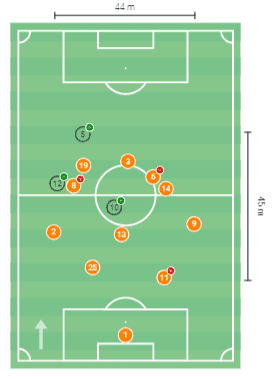
Daly’s role as the number 9 is to drop into pockets of space and interchange positions with Groom and Mewis. This movement creates space and enables Daly to find space in the 18-yard box to receive a return pass from Mewis/Groom or one of the other aforementioned service providers. Their positions are relatively close to each other which can be seen in the graphic above (#3 Daly, #19 Mewis, #6 Groom, #8 Prince, #14 Visalli).
Attacking & transitional phase – Positional intelligence & midfield link-up
Now that we have a better understanding of Dash’s setup and where Daly fits into the system, the next two sections of this analysis will deconstruct Daly’s attributes further. An integral part of Daly’s game is based around her on- and off-the-ball work in the offensive phase of play. Daly relies on her movement and timing to drop in and out of pockets of space to combine and allow players around her to occupy those vacated spaces. Players of this ilk often have nimble footwork and develop a great relationship with the midfield, especially ones who play in the number 10 or aggressive number 8 position, depending on the formation used. Throughout most games, you can often find Daly dropping much deeper, sometimes close to the halfway point to collect possession and transition it forward before heading back into the more attacking areas, which is illustrated in the image below.
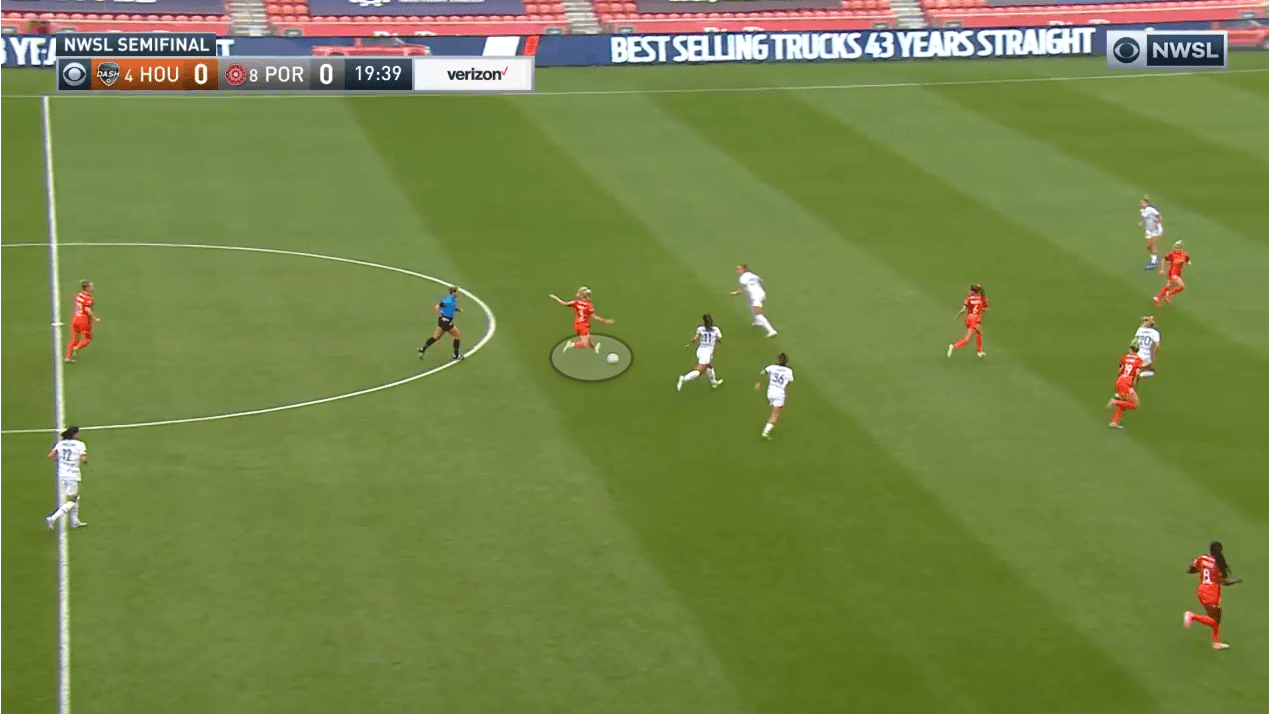
Taking a closer look at Daly’s heat map on the left, we can see that while she is the central striker, a lot of her activity is in the area outside of the 18-yard box, spreading across the left, right, and centre. This indicates Daly is very mobile and active in her play by constantly moving positions but it also indicates that her average position is much deeper.
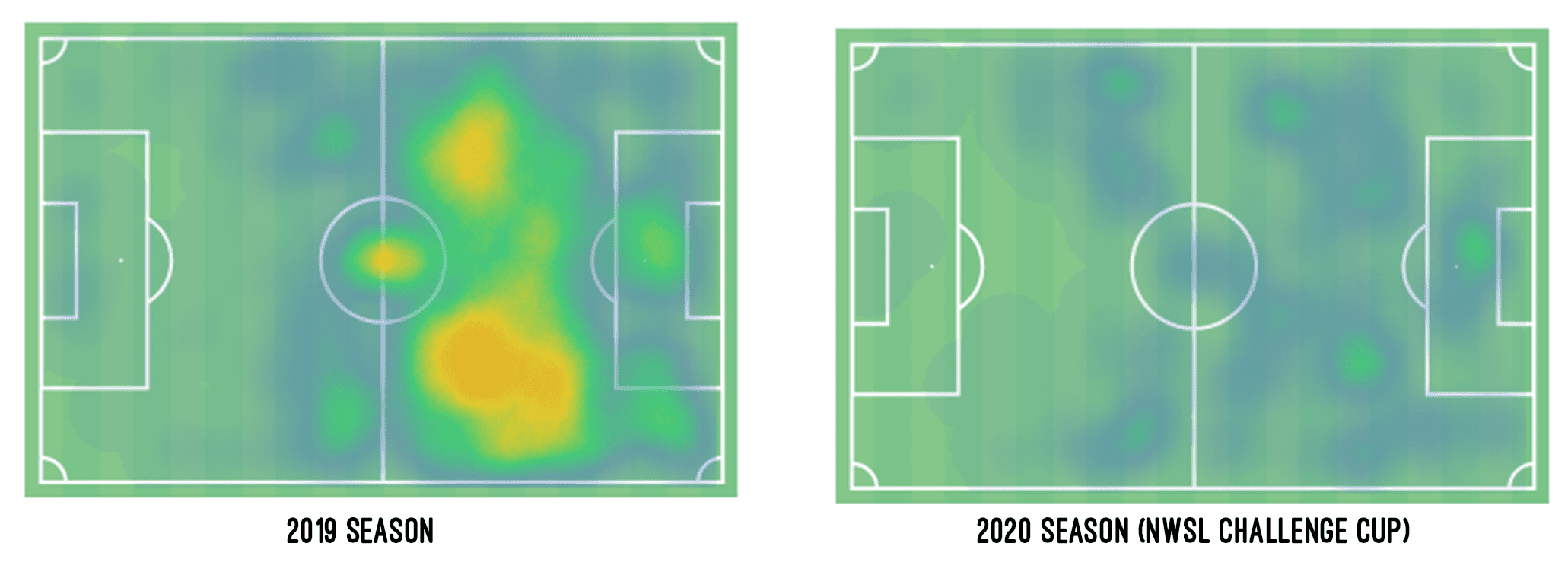
Playing closer to the central attacking midfielders ensures that the focus remains on the three attacking players allowing the wider players space. This is where Daly’s link-up play becomes most apparent and is a core fundamental part of her game. The heat map on the right is from the current NWSL Challenge Cup which follows a similar pattern. If we take a closer look at the statistics, we can see that Daly doesn’t have too many touches in the box at 2.88 in 2019, and even less in 2020 with 1.68 which supports her coverage outside of the 18-yard box. Daly is an excellent reader of the game and understands space around her. What she excels at is collecting possession deep, and picking out a runner in a forward position, bypassing the players marking her.
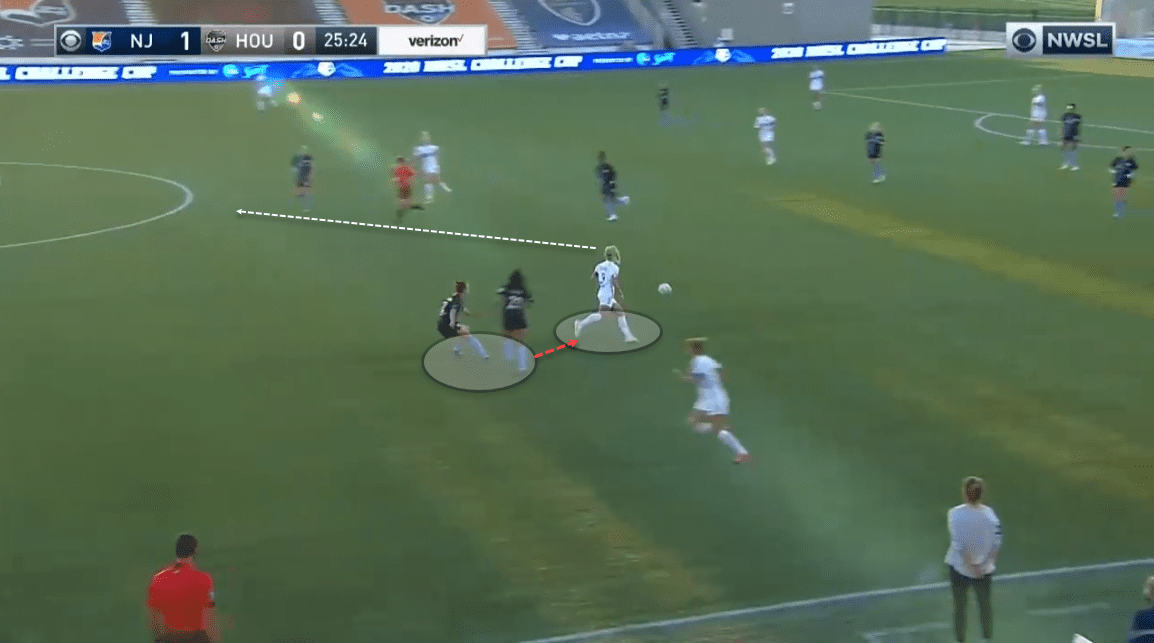
Taking an example from the tournament match against Sky Blue, we can see Daly’s starting position deep in her defensive third with her head turned scanning for a potential pass ahead. There are two players who have pressed the centre-forward, pulling them out of position.
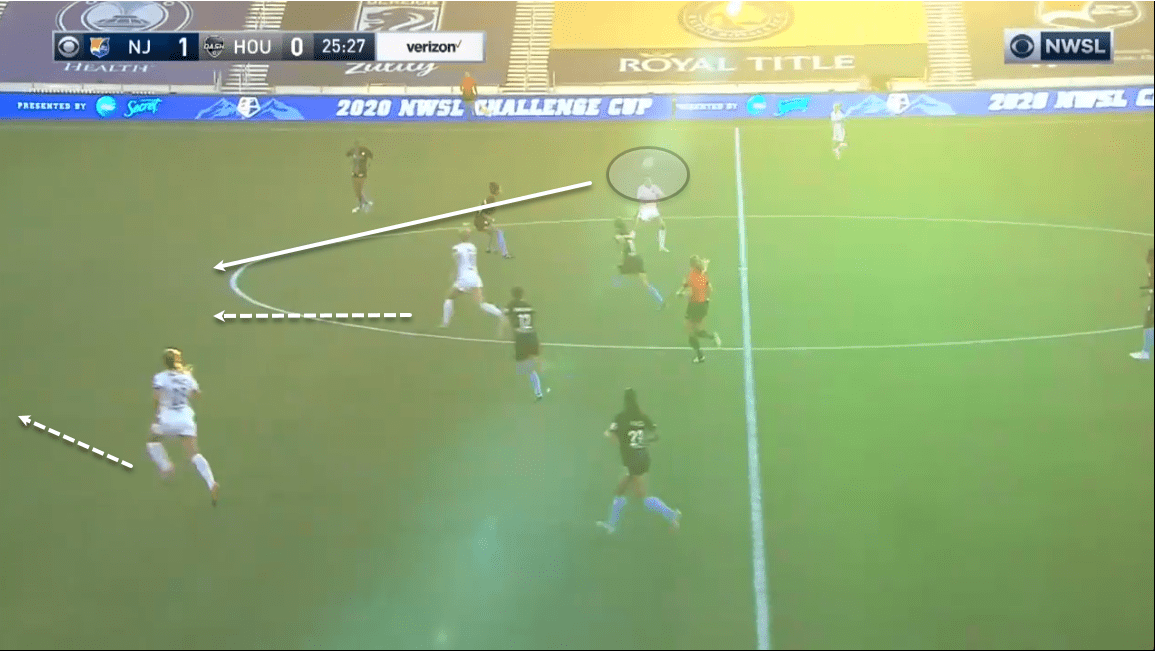
The move to press Daly by the two players has vacated the highlighted space which has allowed two Houston Dash players to run into it. Daly’s pass goes straight to the ball carrier’s head who nods it into the path of the two running players. This pattern of play is a constant theme in Daly’s overall attacking game which sees her create space and potential opportunities to attack the opposition through pulling players out of position.
Daly’s link-up play isn’t limited to finding long passes from deep areas but also when the teams are organised and keep their defensive shape. Playing in the false nine position, Daly’s passing data reflects her frequency of trying to play positive, progressive football. Comparing her numbers between 2019 and 2020, it’s clear to see there is a high frequency of passes attempted in both the final third and penalty area, especially for a striker. Bearing in mind the sample size for 2020 is much smaller than in 2019, the numbers are relatively close.
What is most intriguing though is that Daly’s assists per 90 and expected assists (xA) per 90 are both higher than they were in the 2019 season. In 2019, her assists/90 was 0.06 and xA was 0.05, whilst in 2020 the same numbers increased to 0.19 assists and 0.14 xA. Looking back at the 2019 NWSL season, Daly seemed to play at a slower tempo than she has this season. This affected her decision-making and allowed opposition teams to adjust their positions in time. While she did drop deep, her choice of pass and speed of pass was less effective, which is noticeable in her 2019 statistics.
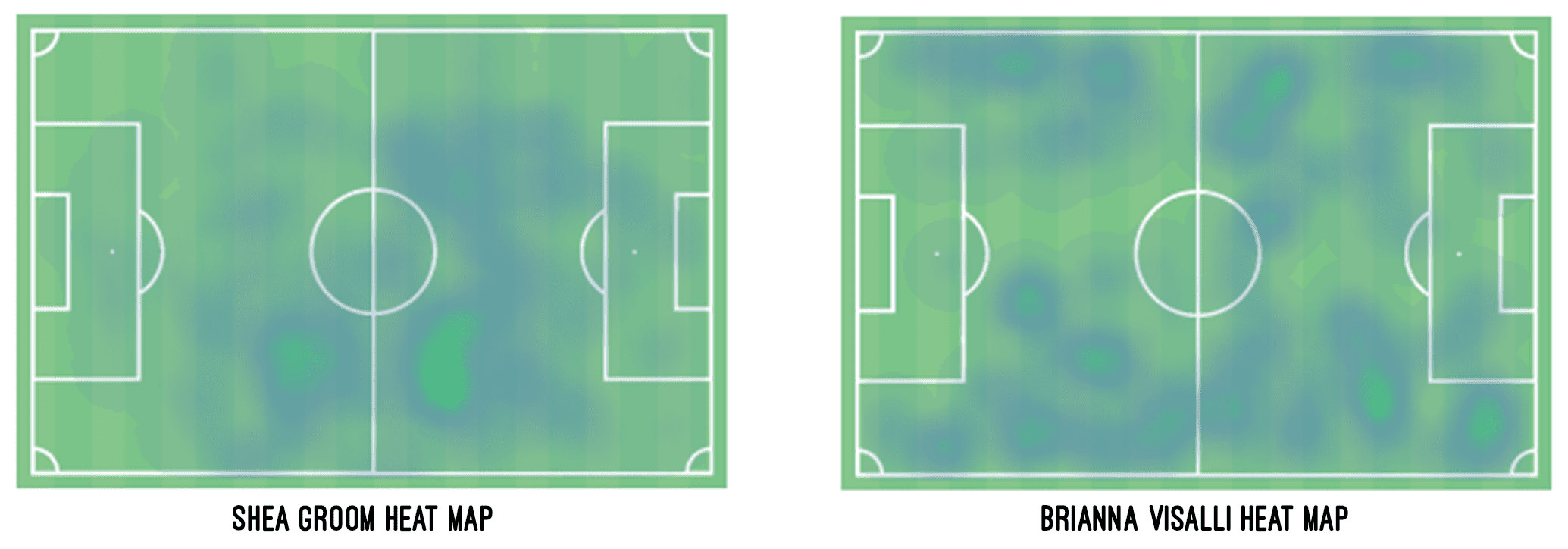
The movement of the players around her is much improved and the addition of Visalli and Groom has forced teams to shift their focus off Daly. The heat maps indicate Visalli’s and Groom’s activity during the tournament and show their movements around the 18-yard box. This has allowed Daly to find more spaces and though her frequency of dangerous passes is lower, her assists and xA is higher because she’s able to do more in the space given to her and a byproduct of this has been her goal-scoring exploits. Daly has benefited from the space by applying her positional awareness better than she used to.
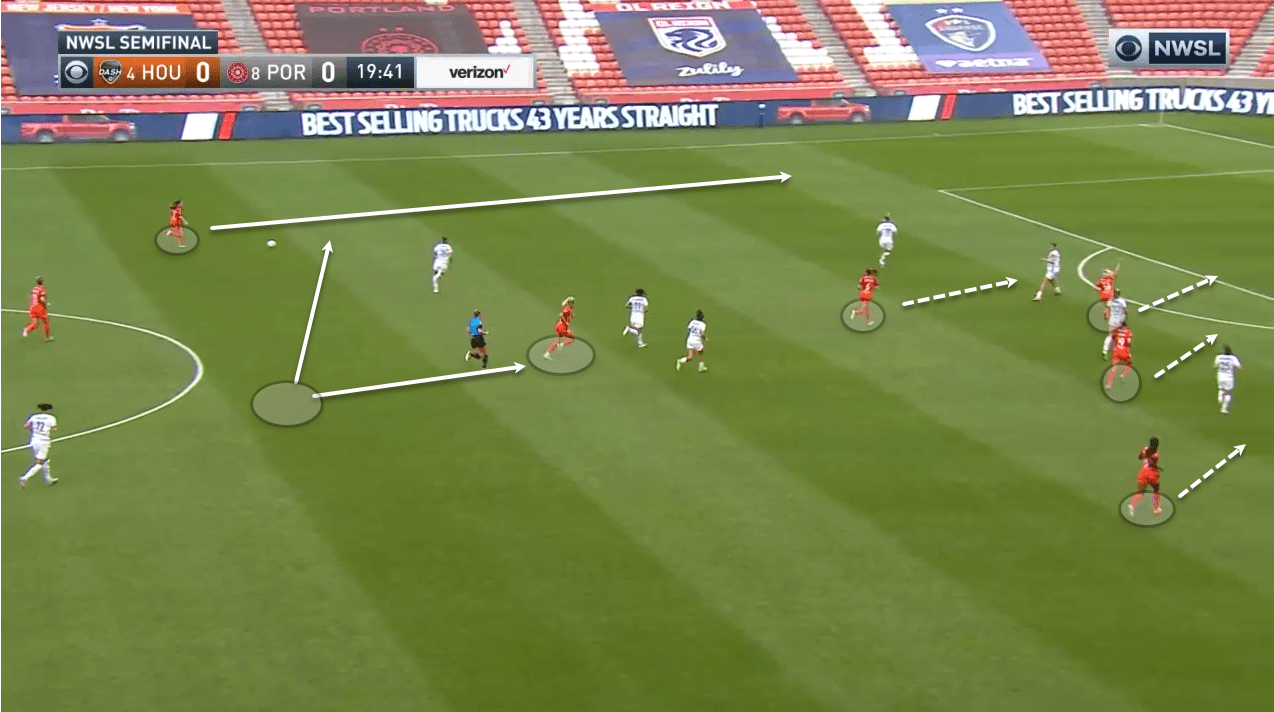
This example illustrates these changes well and how Daly is able to apply her positional awareness and intelligence in attacking situations. Here, Daly picks up possession and plays it out wide to Allysha Chapman with Groom, Mewis, Visalli, and Prince all headed towards the box.
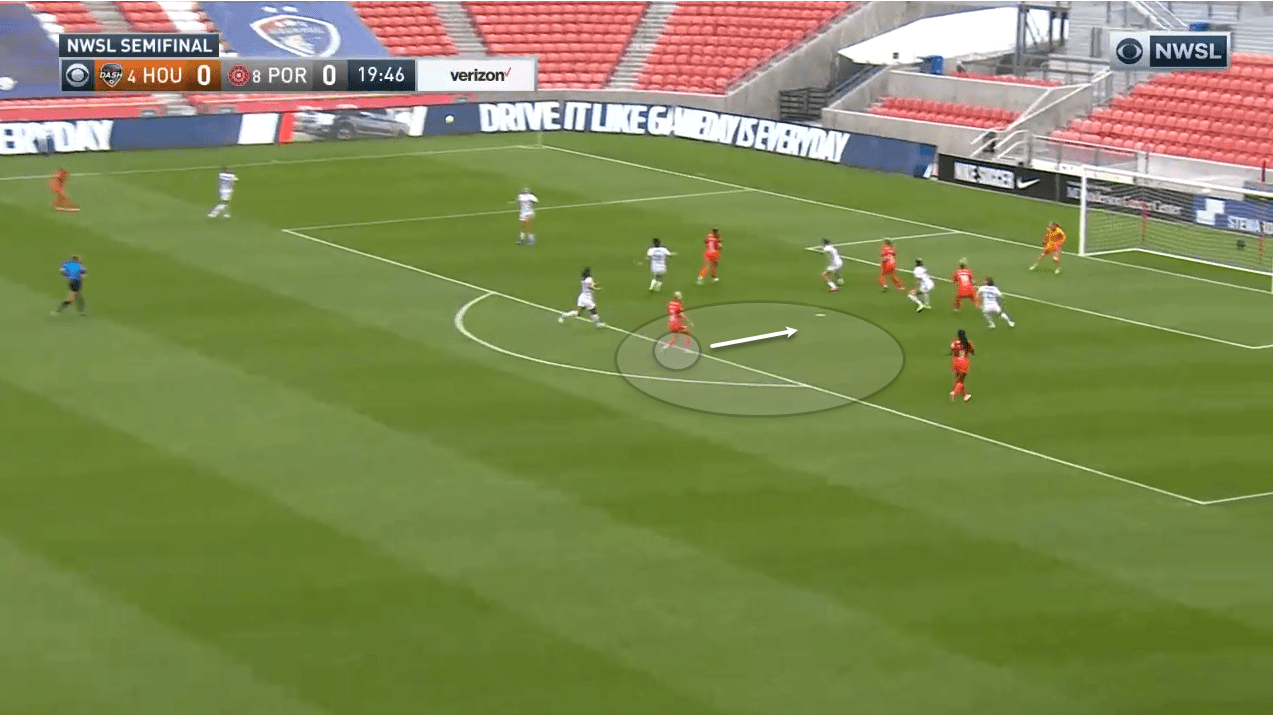
What is most interesting is Daly is the last player to arrive in the box and in this situation, it creates a situation whereby she can ghost through unmarked and pick up the second ball. Even the closest Portland Thorns defender is ball watching whilst the others are marking the aforementioned attackers. The presence of mind to arrive late and make shorter, more sudden bursts in the 18-yard box makes Daly a dangerous proposition to face against.
Defensive phase – Off the ball pressing
Daly has played numerous matches as a defender, specifically at right-back for the Lionesses. The skills she’s acquired playing in this position has translated to her position as a centre-forward. Daly’s most proficient skill defensively is her pressing ability which is seen throughout her games. When Houston Dash are off the ball, the team move back into their 4-1-4-1 formation with the two central midfielders pushing up alongside Daly to pressure the opposition central defenders. In this case, they are able to press in sync and apply enough pressure to force a mistake, just as the image below portrays. From here, Daly presses Washington Spirit’s central defender with Mewis following suit by predicting the next pass to close the other Spirit player. Daly will more often than not be the further forward player when the Houston Dash sit deep and create their solid defensive shape. From here, Daly is a willing runner when played long and relishes a duel.
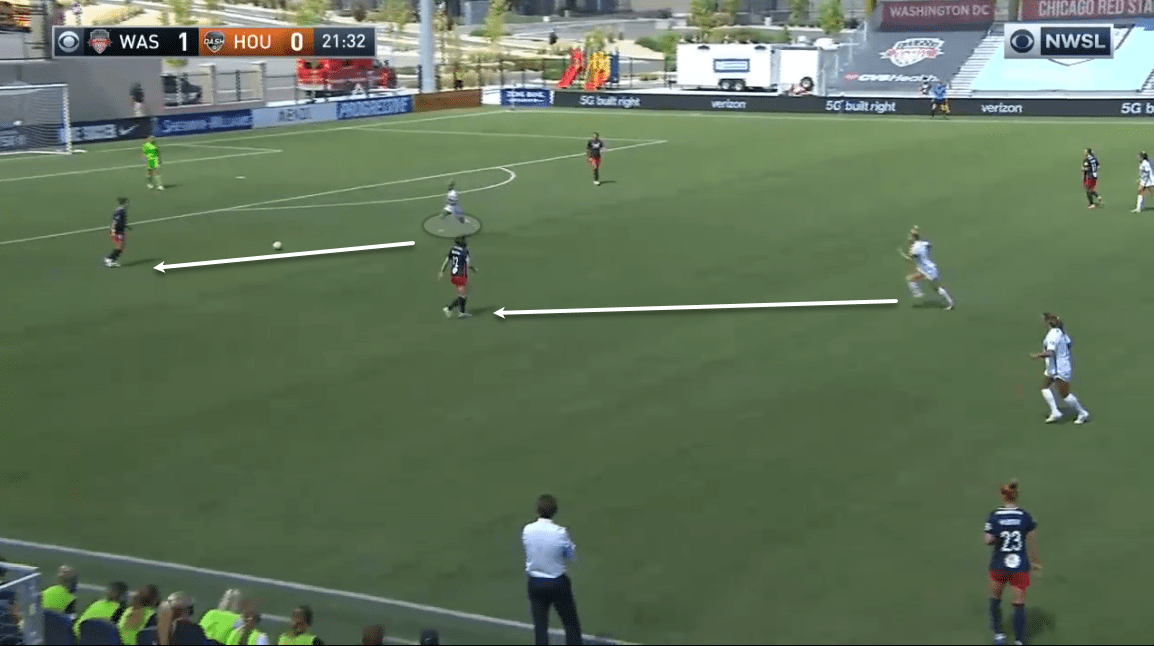
Daly isn’t limited to pressing higher up the pitch, as we’ve discussed Daly’s preference to drop into the middle and defensive thirds, and this is another area where we’ve seen Daly exert her aggressive pressing to win back possession. If we take a closer look at the statistics, Daly has averaged 2.99 defensive duels/90 with an 81% success rate. Alongside that, she has figures of 3.73 recoveries and 2.05 interceptions/90. These figures, whilst not the highest, still show the type of forward she is.
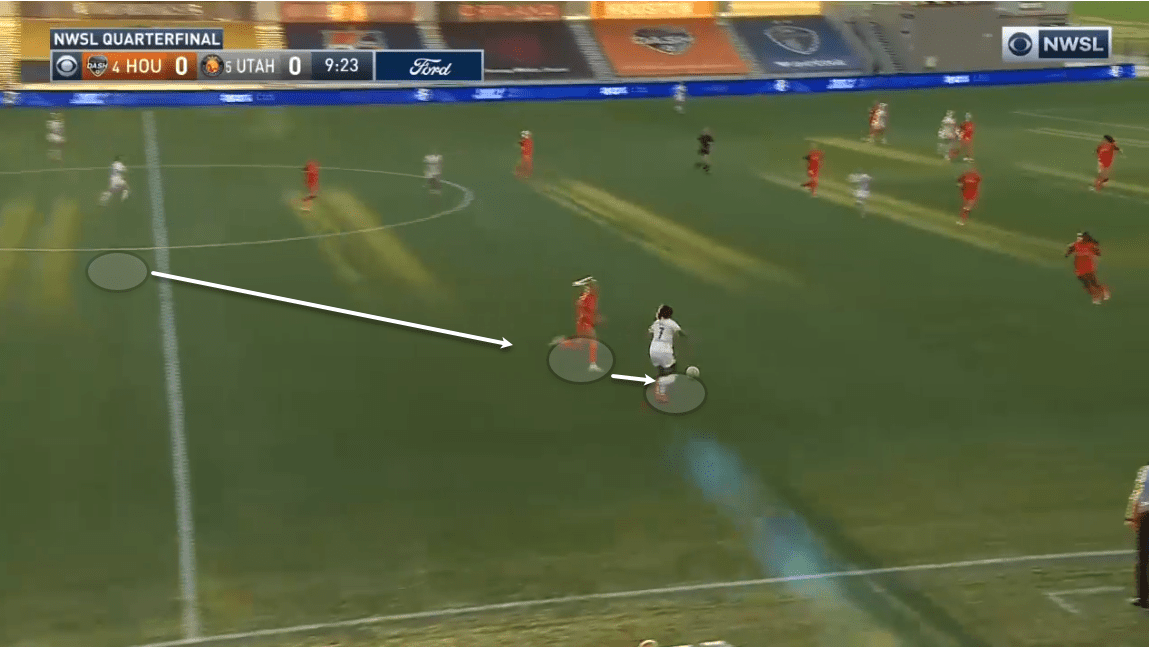
This example shows Daly quickly pressing Utah Royals’ Elizabeth Ball to not allow any further ball progression which could, in turn, lead to a turnover and a potential counter-attacking opportunity for Houston Dash. Daly’s aggressiveness is disruptive to opposition defences that look to build out from the back, and when timed with Groom and Mewis, is devastating.
Areas of Improvement
Whilst Daly has been such a crucial player for Houston Dash and arguably one of the best attacking players of the tournament, however, based on the footage and data there are areas of improvement. One of Daly’s weaker attributes is her ability to hold possession and hold-up play. Her ability to keep possession and hold the ball to wait for players to move around her with opposition players pressing is not as strong as other aspects of her play. Daly has the fourth-highest ball losses rate for the Dash in the NWSL Challenge Cup, averaging 11.4 losses/90.
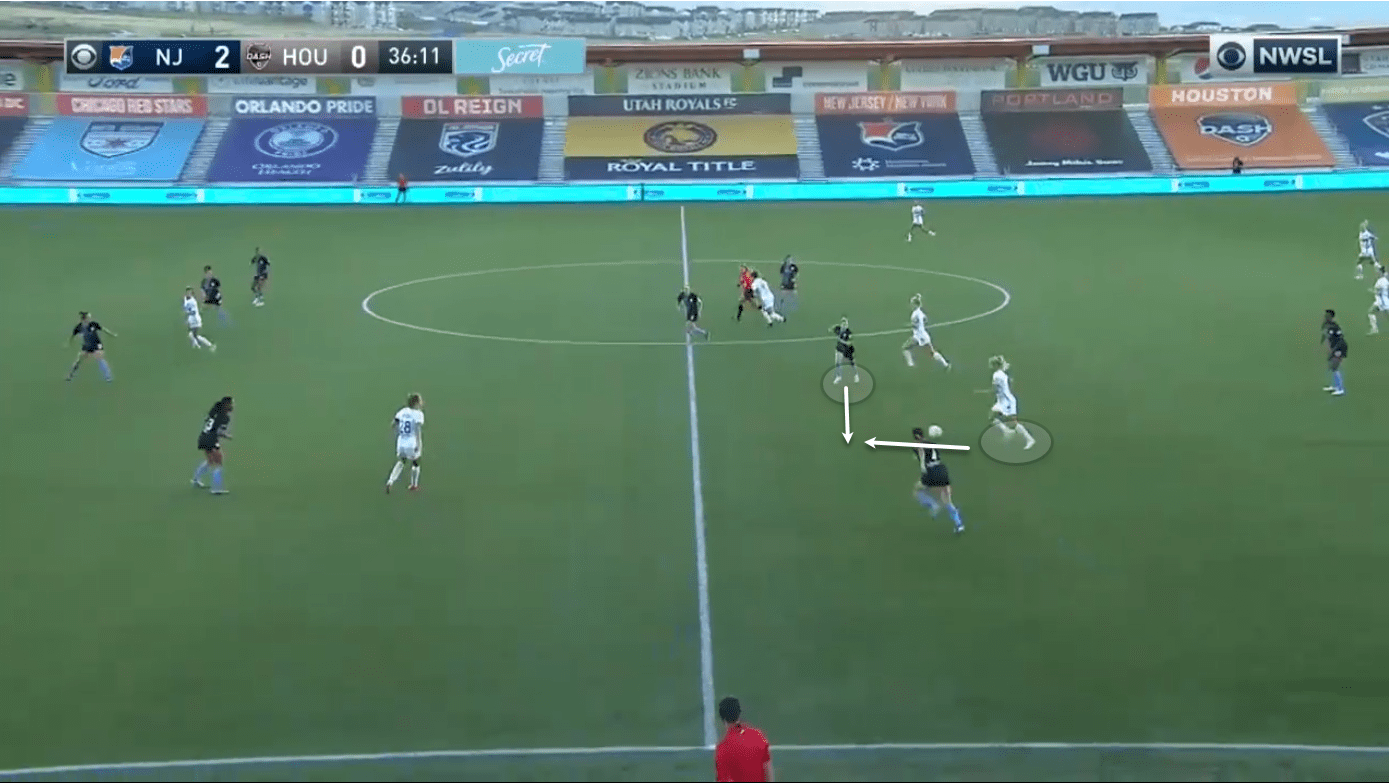
After analysing footage of the way she loses possession, a lot of what I’ve noticed is while she’s excellent at a higher tempo of play with quick interchangeable passes, any time she receives the ball in advanced areas and needs to hold on to the ball a bit longer, there seems to be a slight lack of composure. There are times when her first touch will let her down, being too heavy and pushing the ball too far away from her which allows the opposition to dispossess her as we can see in the image above. This has led to some attacks being broken down, and if Daly can improve her hold-up play then she can become an exciting complete forward.
Are there better centre-forwards in the NWSL?
To complete the analysis, I will compare Daly to the three other strikers from the teams in the semi-finals. In doing so, we can see if the statistics give us a clearer indication of Daly’s performances and how she compares to the leagues other centre-forwards. All data used is per 90 minutes.
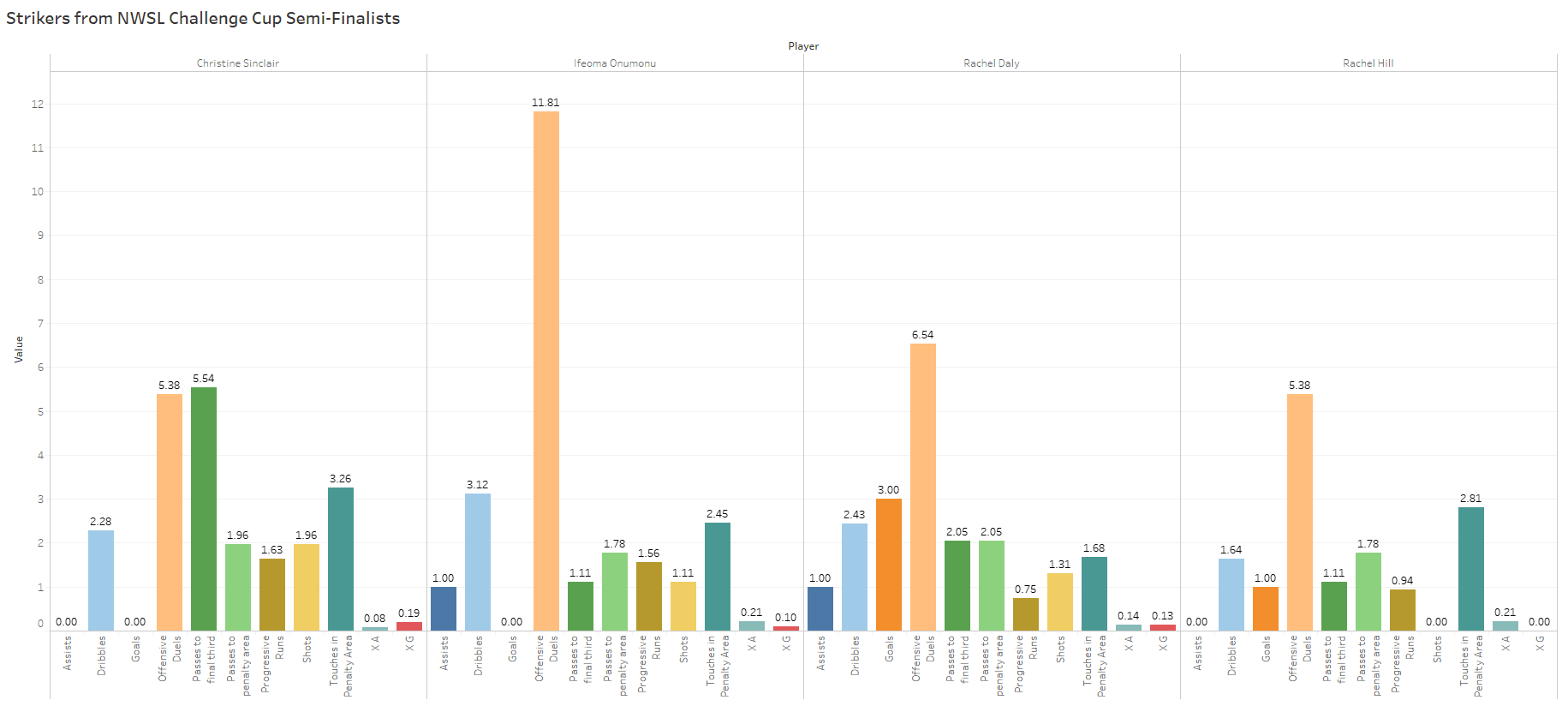
At first glance, we can clearly see where Daly is more superior. Firstly, she has the most goals in the tournament while she also attempts more passes, which is a reflection of her role in the side. As we discussed earlier, she plays as a false nine, which means her passing will be more frequent because of the nature of the role. Dropping deep, creating space to then play forward passes is a critical part of Daly’s game which illustrates her playmaking side. Other statistics such as shots and touches in penalty area are also indicative of Daly’s role, so while overall she may not have the best statistics against the other strikers, they work in Houston Dash’ system perfectly.
Final Remarks
After such a successful period for Daly, I think teams will now start to focus and plan more around stopping her. The way she moves and uses her teammates’ progressive running and dribbling to find pockets of space is undeniable. Clarkson’s system is built around the strongest qualities of his team but also one that is not reliant on specific players but rather a role. However, finding and replicating Daly’s skillset will be extremely challenging if she were to leave. The striker is one of a kind and her aggressive nature is a major strength to her play and one I think that sets her apart from the rest. Based on her performances here, Phil Neville should consider using Daly as a centre-forward or even number ‘10’. I truly think her skillset is one that can be perfectly suited to a withdrawn role. For these reasons and how important Daly is to Houston Dash, she is my and the tournament’s MVP.

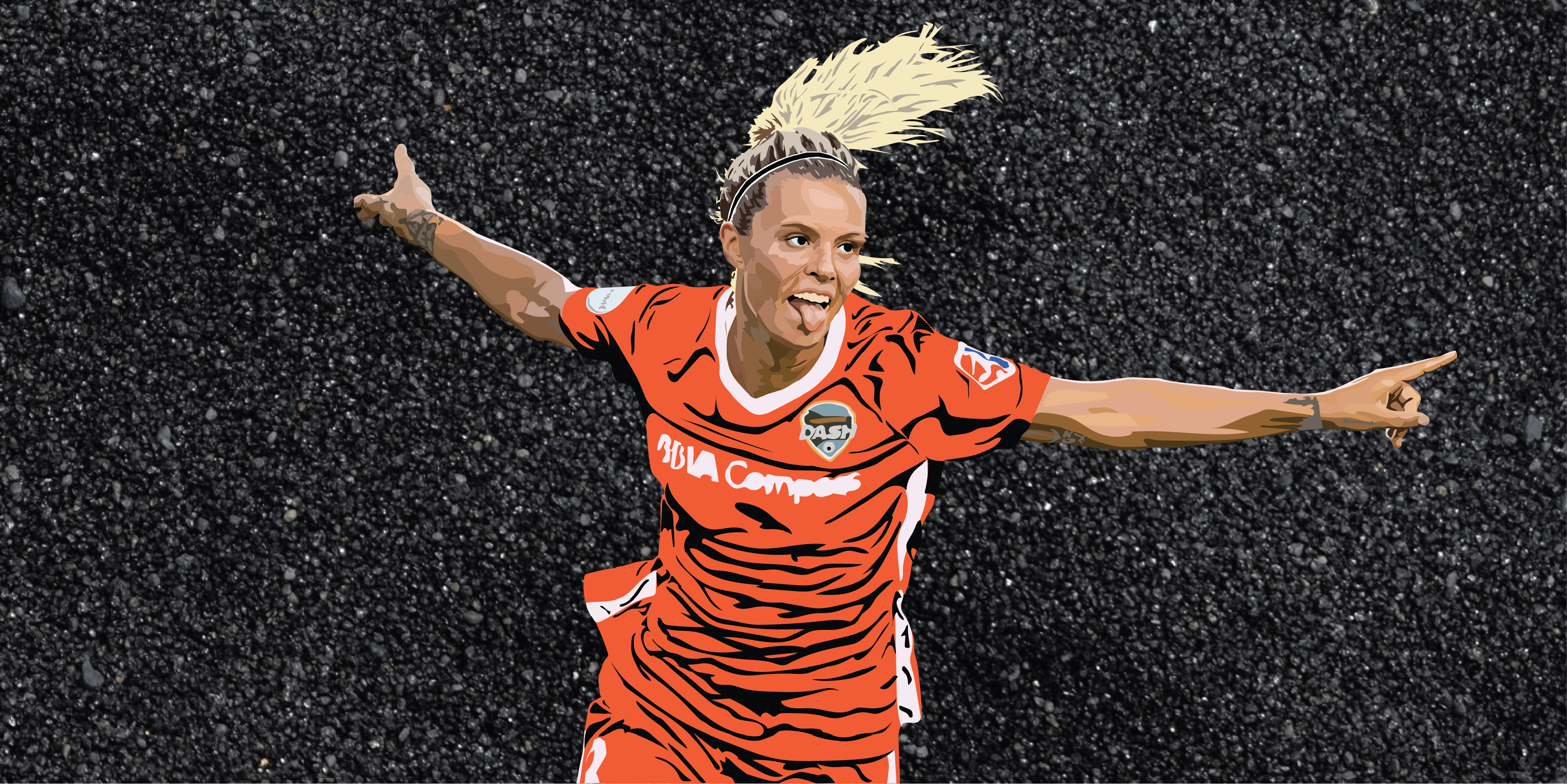




Comments